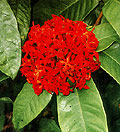By Heidi Bornhorst
Special to The Advertiser
Q. I love ixora. I think the red one is really nice. How come they look so junk sometimes? Is there such a thing as a "tree ixora"?
A. Ixora is a great landscape and garden plant.
 |
| “Gardening in Hawai’i” photo |
I once asked Earl Morita, team leader for landscaping at the Hale Koa Hotel, what his favorite plant was. "Red ixora," he replied. "But, Earl, it can look so junky with black, sooty mold on the leaves and chlorotic yellow-green leaves," I countered. "Yes, but in the right place, it is awesome," he replied.
Ixora is usually a bush or shrub. There is the red ixora, which I have come to appreciate more and more, thanks to Earl. It has large red heads made of a bunch of individual red-orange flowers. The flowers are about 3/4 inch in diameter and are simple five-petaled blossoms on a short stem.
There are many other colors of ixora: yellow, orange and white.
Ixora is an old-fashioned, tough plant. Once I was working on restoring an old kama‘aina coastal garden and there was the red ixora in a hedgerow. It had been neglected and was growing in a sandy coral soil, yet it looked great! It had no pests and not a trace of sooty mold on the leaves, and its flowers were very full and glorious.
Ixora is in the gardenia family. Like other members of the Rubiaceae family, it likes acid soil. This is why it looks off-color, or chlorotic, in some soils. Like gardenias, ixora prefer the rich organic red or brown dirt soils of the cooler, more upland regions of the Islands. If you live near the beach or have sandy soil, add lots of organic compost or peat moss to make the soil richer and more acidic so your ixora or other acid-loving plants, such as gardenias and azaleas, will thrive.
To answer your question, there is a tree ixora. It is a small to medium-size tree, reaching 10 to 25 feet high in time. It has clusters of white, sometimes fragrant flowers. It has the scientific name ixora fragrans. There are a couple trees in Foster Garden and one in Kapi‘olani Park. Although it is not a common plant, you do see it in older landscaping. It would be a good choice for small-scaled gardens and backyards.
My mom’s lovely secretary Mitzi used to make the most exquisite lei from ixora. She would get the finest needles from a fishing supply store, the finest suji (fishing line) for lei string and patiently string the small flowers into a lei.
Ixora is native to tropical regions of Asia. There are several species, and many of them have been in Hawai‘i for quite a while. Ixora has been given the Hawaiian name popo lehua (roughly translated, "a ball of pompoms like the ‘¯hi‘a lehua").
Some nurseries have been bringing in new varieties from Thailand that are a lovely addition to our Hawai‘i landscapes. We found the fragrant, large-flowered ixora fragrans at Moriwaki nursery. We used it for winter color and fragrance at the entrance to the lu‘au garden at the Hale Koa Hotel.
Heidi Bornhorst is director of the city’s botanical gardens. Write to her in care of The Advertiser Homestyle section, P.O. Box 3110, Honolulu, HI 96802. Or e-mail her at islandlife@honoluluadvertiser.com
[back to top] |

 The Great Index to Fun
The Great Index to Fun